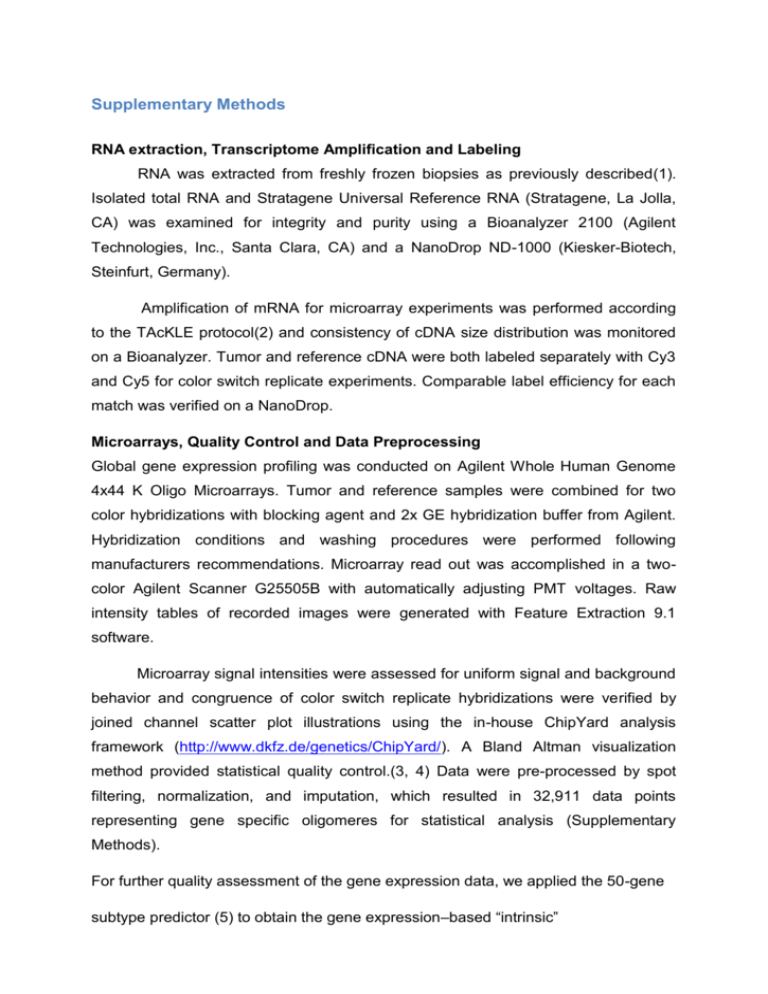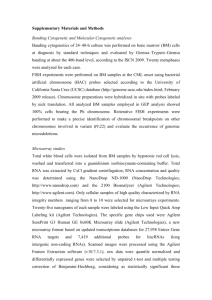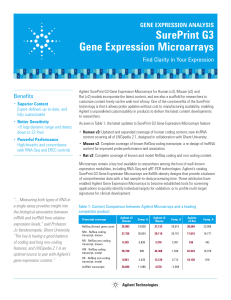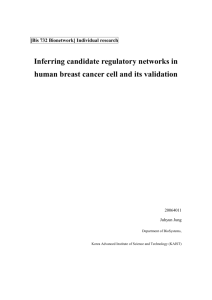RNA extraction, Transcriptome Amplification and Labeling
advertisement

Supplementary Methods RNA extraction, Transcriptome Amplification and Labeling RNA was extracted from freshly frozen biopsies as previously described(1). Isolated total RNA and Stratagene Universal Reference RNA (Stratagene, La Jolla, CA) was examined for integrity and purity using a Bioanalyzer 2100 (Agilent Technologies, Inc., Santa Clara, CA) and a NanoDrop ND-1000 (Kiesker-Biotech, Steinfurt, Germany). Amplification of mRNA for microarray experiments was performed according to the TAcKLE protocol(2) and consistency of cDNA size distribution was monitored on a Bioanalyzer. Tumor and reference cDNA were both labeled separately with Cy3 and Cy5 for color switch replicate experiments. Comparable label efficiency for each match was verified on a NanoDrop. Microarrays, Quality Control and Data Preprocessing Global gene expression profiling was conducted on Agilent Whole Human Genome 4x44 K Oligo Microarrays. Tumor and reference samples were combined for two color hybridizations with blocking agent and 2x GE hybridization buffer from Agilent. Hybridization conditions and washing procedures were performed following manufacturers recommendations. Microarray read out was accomplished in a twocolor Agilent Scanner G25505B with automatically adjusting PMT voltages. Raw intensity tables of recorded images were generated with Feature Extraction 9.1 software. Microarray signal intensities were assessed for uniform signal and background behavior and congruence of color switch replicate hybridizations were verified by joined channel scatter plot illustrations using the in-house ChipYard analysis framework (http://www.dkfz.de/genetics/ChipYard/). A Bland Altman visualization method provided statistical quality control.(3, 4) Data were pre-processed by spot filtering, normalization, and imputation, which resulted in 32,911 data points representing gene specific oligomeres for statistical analysis (Supplementary Methods). For further quality assessment of the gene expression data, we applied the 50-gene subtype predictor (5) to obtain the gene expression–based “intrinsic” subtypes luminal A, luminal B, HER2-enriched, normal-like and basal-like. Intrinsic subtyping prediction is based on a nearest shrunken centroid system using 50 genes, called the Pam50 classifier. Achieving pCR rates in the subtypes for luminal A <10%, luminal B around 10-20%, basal-like and erbB2+ around 30-50% (without Trastuzumab) would conclude that the gene expression data is of sufficient quality (57). To incorporate measurement bias a median gene centering as calibration method was performed before the Pam50 classifier was applied. CD24 is represented by oligo A_23_P114457, which perfectly matches the CD24 sequence on chromosome 6q21. 1. Thuerigen O, Schneeweiss A, Toedt G, Warnat P, Hahn M, Kramer H, et al. Gene expression signature predicting pathologic complete response with gemcitabine, epirubicin, and docetaxel in primary breast cancer. J Clin Oncol. 2006 Apr 20;24(12):1839-45. 2. Schlingemann J, Thuerigen O, Ittrich C, Toedt G, Kramer H, Hahn M, et al. Effective transcriptome amplification for expression profiling on sense-oriented oligonucleotide microarrays. Nucleic Acids Res. 2005;33(3):e29. 3. Bland JM, Altman DG. Statistical methods for assessing agreement between two methods of clinical measurement. Lancet. 1986 Feb 8;1(8476):307-10. 4. Bland JM, Altman DG. Measuring agreement in method comparison studies. Stat Methods Med Res. 1999 Jun;8(2):135-60. 5. Parker JS, Mullins M, Cheang MC, Leung S, Voduc D, Vickery T, et al. Supervised risk predictor of breast cancer based on intrinsic subtypes. J Clin Oncol. 2009 Mar 10;27(8):1160-7. 6. von Minckwitz G KM, Kümmel S, Fasching P, Eiermann W, Blohmer J-U, Costa SD, Sibylle L, Dietmar V, Untch M, editor. Integrated meta-analysis on 6402 patients with early breast cancer receiving neoadjuvant anthracycline-taxane +/trastuzumab containing chemotherapy. SABCS - San Antonio Breast Cnacer Symposium; 2008; San Antonio. 7. Carey LA, Dees EC, Sawyer L, Gatti L, Moore DT, Collichio F, et al. The triple negative paradox: primary tumor chemosensitivity of breast cancer subtypes. Clin Cancer Res. 2007 Apr 15;13(8):2329-34.











